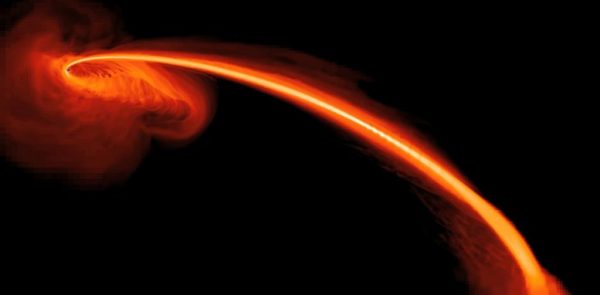Black Hole Shredding a Star Leads to a New Astronomical Discovery – SciTechDaily

This computer-simulated image shows gas from a tidally shredded star falling into a black hole. Some of the gas also is being ejected at high speeds into space. Astronomers observed the flare in ultraviolet light using NASA’s Galaxy Evolution Explorer, and in optical light using the Pan-STARRS1 telescope on Mount Haleakala, Hawaii. The light comes from gas falling into the black hole, and glowing helium from the star’s helium-rich gas expelled from the system. Image credit: NASA/JPL-Caltech/JHU/UCSC
When a black hole chews up a star, we see this either in visible light or in X-rays, but almost never through both types of radiation. Astronomer Peter Jonker (SRON / Radboud University) and his colleagues have now spotted a number of captured stars with an X-ray telescope, a few years after they were discovered in optical light. It appears that black holes all dine in the same way after all, while the mood lighting varies according to a fixed pattern. This discovery was published in The Astrophysical Journal on February 4, 2020.
All across the Universe, gigantic black holes are lurking in the dark within centers of galaxies. Like an ambush predator they patiently wait for unsuspecting stars to fly by, then use their overwhelming gravity to pull it apart into a spaghetti strand and finally swallow it up. Astronomers sometimes see this spectacle in visible light, sometimes in X-rays, but almost never in both types of light at the same time. Do black holes have two different ways of eating a star?
From visual to X-ray
Astronomer Peter Jonker (SRON / Radboud University) and his international colleagues now see a number of sources with the Chandra X-ray telescope that were identified in the optical a few years earlier. It appears that a star, in the process of being devoured, first radiates visible light and subsequently emits X-rays. So black holes have a lot in common after all in terms of eating behavior, while the mood lighting during dinner changes according to a fixed pattern, from gentle white to pale bright X-rays. Jonker’s finding can soon be tested by combining data from the recently launched X-ray satellite eROSITA—a predecessor of Athena—and telescopes that sweep the sky in visible light, such as the BlackGEM telescope which is currently being installed in Chile under supervision of Radboud University.
Collision
A captured star is stretched into such a long string that it encounters itself after a full orbit around a black hole, like a snake biting its tail. That collision causes the string to lose altitude and fall towards the black hole. Jonker has two possible explanations for his theory that visible light and X-rays are both released, strictly in that order.
The first option is that we see the visible light because of the energy released during the collision, and that we see the X-rays because potential energy is lost during the drop towards the black hole. The string—at this point more like a gas stream—starts to glow like a so-called black body, with a characteristic curve as a spectrum that peaks in soft X-rays.
The second option is that the collision itself emits X-rays, but a dense cloud emerges that absorbs the X-rays and re-emits them as visible light. Only when enough star material has disappeared, the cloud is thin enough to allow the X-rays to pass through, including the X-ray radiation as a result of the plunge with associated loss of potential energy.
Rotation
A consequence of Jonker’s theory is that there is a connection between the rotation of black holes and the amount of X-rays emitted by stars while being eaten. Whether black holes rotate at all is currently unknown. If eROSITA will see hundreds of spaghetti strands every year, the theory says that black holes are rotating. If only a few are detected each year, it would indicate stationary black holes.
Reference: “Implications from Late-time X-Ray Detections of Optically Selected Tidal Disruption Events: State Changes, Unification, and Detection Rates” by P.G. Jonker, N.C. Stone, A. Generozov, S. van Velzen and B. Metzger, 4 February 2020, The Astrophysical Journal.
DOI: 10.3847/1538-4357/ab659c





